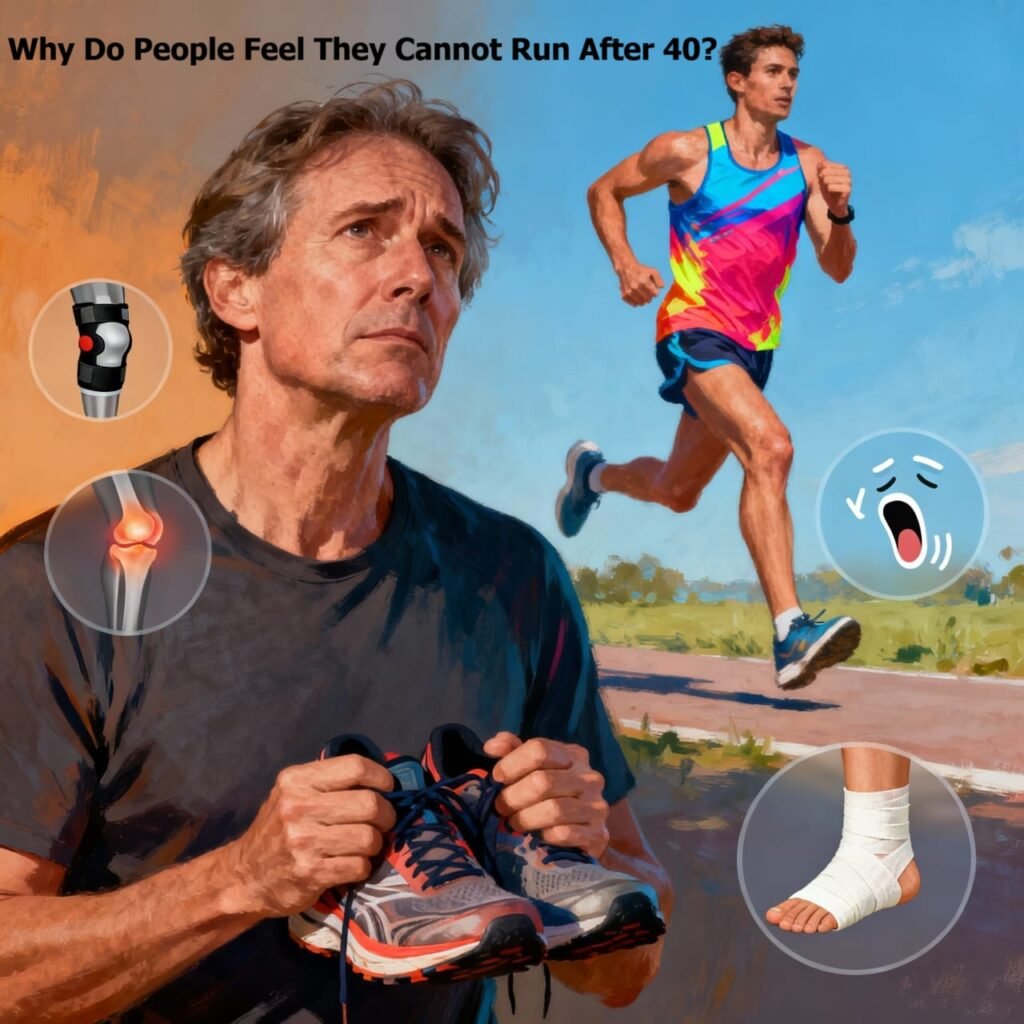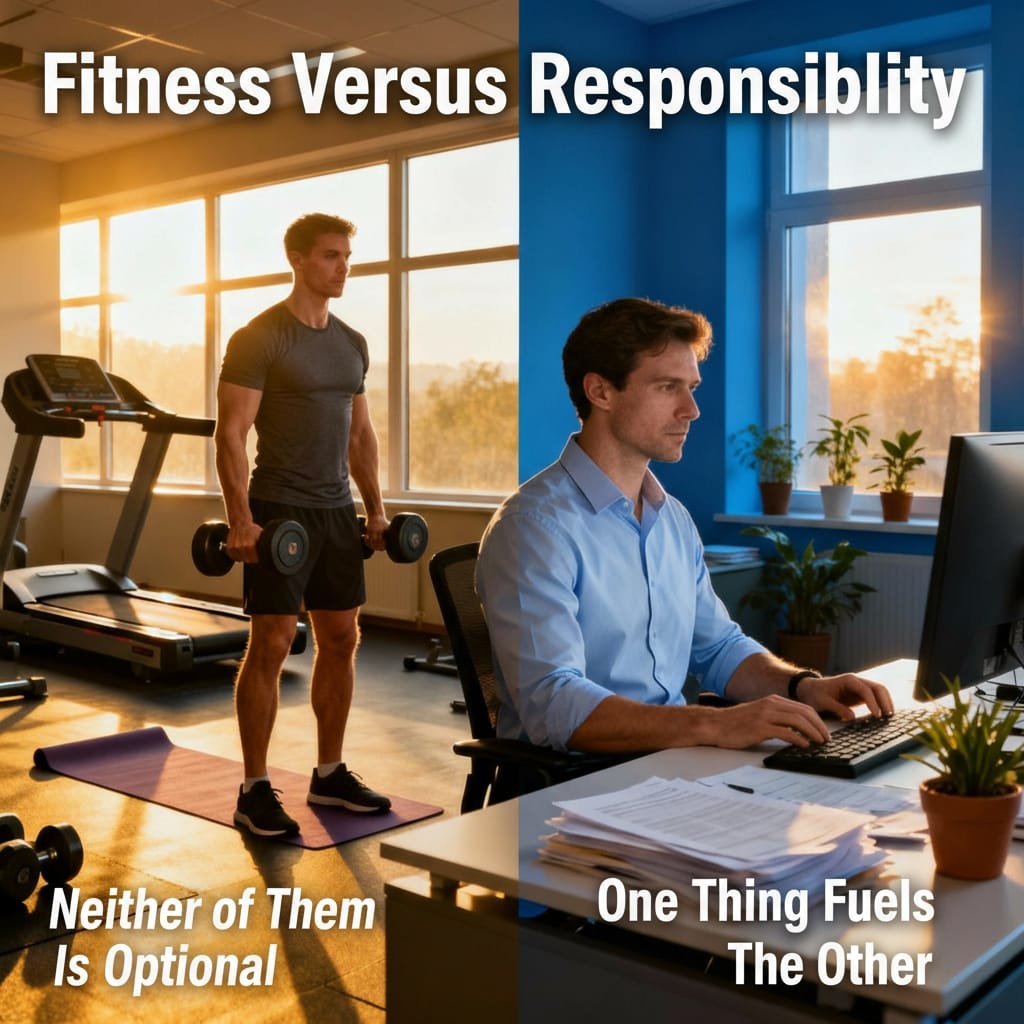- Why It Feels Harder to Run After 40
- Fitness vs. Responsibility: You Don't Have to Choose – You Need Both
- Solution – Build A Sustainable Routine That You Can Actually Follow
- Final Words
It’s pretty common to feel that your running days are behind you once you cross 40. Perhaps your body feels inadequate, your schedule is packed, or you’ve simply gone too long without lacing up your shoes. If you’ve ever thought, “I just can’t run anymore,” you’re not alone. But where does that belief come from – and is it truly grounded in reality? To understand why so many people hesitate to run after 40, we need to look deeper.
What physical changes trigger this doubt? What emotional and lifestyle pressures reinforce it? And most importantly, is there a way to block those triggers and actually lace up your running shoes again?

Why It Feels Harder to Run After 40
The hesitation to run after 40 isn’t just about aging; it’s a layered mix of physical changes, psychological barriers, and lifestyle pressures. These hurdles don’t show up overnight. They build quietly over years of sedentary habits, shifting priorities, and fear of injury. Let’s unpack each one to understand where this resistance comes from, and how to navigate it in a way that makes running after 40 not just possible, but sustainable too.
Physical Hurdles That Make It Difficult to Run After 40
Many people feel they cannot run after 40, especially if they haven’t done so in their 30s. These thoughts are often triggered by slow, subtle changes in the body that accumulate over a decade or more. Without regular movement, your body begins to feel unsuitable for physical activity, and that perception gradually chips away at your confidence.
Here’s what’s happening beneath the surface:
- Muscle Mass Decline – After age 30, we lose 3-8% of muscle mass per decade – a process called sarcopenia. The rate varies depending on how consistently you load your muscles, or not. Less muscle means less power, slower strides, more pressure on joints, and reduced shock absorption during runs.
- Reduced Flexibility and Mobility – As muscles shorten and connective tissues stiffen, joint range of motion declines. Tendons and ligaments lose elasticity, increasing injury risk and affecting stride length, hip mobility, and ankle stability.
- Cartilage Brittleness – Cartilage loses its cushioning ability, especially in the knees and hips. Without regular strength and mobility work, this can lead to discomfort, inflammation, or joint damage.
- VO₂ Max Decline – VO₂ max – your body’s ability to use oxygen- drops by about 10% per decade after 30. VO₂ Max Decline makes running after 40 feel harder, even at slower paces, and can leave you breathless sooner than expected.
- Weight Gain and Metabolic Shift – A slower metabolism combined with reduced activity often leads to weight gain – a common midlife concern. Extra weight increases joint stress and makes your body movement feel sluggish. Spoiler alert: running after 40 can help reverse this, especially when paired with a caloric deficit.
- Balance and Coordination Changes – Aging affects proprioception and neuromuscular control, making you more prone to tripping or terrain anxiety. Balance and coordination are just as vital as strength and cardio for midlife runners.
- Recovery Lag – Your body takes longer to recover from exertion. Without adequate rest, hydration, and nutrition, soreness lingers and motivation dips. Can the recovery rate improve after 40? Absolutely – and we’ll explore how later in this post. There’s always room for improvement, and with the right strategies, you can overcome these hurdles.
- Hormonal Decline – Drops in testosterone, estrogen, and growth hormone affect energy, muscle repair, and mood – all key drivers of your strength and motivation to run after 40.

Besides the hurdles mentioned above, women face a uniquely challenging transition in their mid-40s: the onset of perimenopause and menopause. This phase can bring shifts in energy, joint sensitivity, and recovery time, making injury prevention even more critical, but it doesn’t mean giving up running. With the right strategies, women can adapt their training, support hormonal changes, and continue running strong. I’ve shared practical tips and empowering guidance in my post – How to Continue Running During Menopause Phases and Stay Fit – because staying active through this stage is absolutely possible.
Emotional Barriers Resisting Your Half-Hearted Desire to Run After 40
Your 40s can feel like a high-stakes phase, where mistakes seem costlier, recovery feels slower, and fear of injury looms larger than ever. One twisted ankle, one sore knee, and suddenly you’re out of action for weeks. That kind of risk feels unacceptable when you’re juggling work, family, and responsibilities, but if you don’t challenge that fear, it only grows stronger.
I’ve run every day through my 40s, and have faced those emotional battles head-on. Let me make it clear: it’s not a one-time breakthrough. It’s an ongoing process of rebuilding trust in your body, one run at a time.
We often see elite athletes retire in their mid-30s and assume it’s time to let go of physical workouts. But here’s the truth: most sportspeople may step away from high-octane competition, but they don’t stop training.
Can you imagine Usain Bolt telling the world he now struggles and pants while climbing stairs – because he skipped workouts for a few years? No one expected to hear that from the king of sprinting. But even legends need to maintain their fitness. Long story short: fitness isn’t reserved for your prime years. It’s a lifelong responsibility.
Don’t let professional retirement stories define your personal fitness journey. Whether you were an athlete or not, your body still deserves movement, care, and strength after 40. Running isn’t about chasing medals – it’s about reclaiming your energy, your confidence, and your joy
Financial Pressures and Responsibilities Make It Tough to Run After 40
The 40s are often called the midlife crisis phase for a reason. You’re not too old, but you’re no longer young. It’s the decade when many of us wake up to the realization that we’ve entered the second half of our lives, and suddenly, the pressure to “get it all right” intensifies.
We chase responsibilities with urgency: buying a home, funding our children’s education, growing a business, securing financial freedom, and planning for retirement. These goals are valid. Money gives us stability, recognition, and the freedom to dream bigger, but in the rush to build a future, fitness often gets sidelined.
Most of those who’ve “made it” with steady income and settled lives frequently neglect their health. The irony? This is the very decade when the body begins to deteriorate, and yet we tell ourselves there’s no time to do anything about it. There’s always something more urgent.
Here are the questions you need to ask:
- At what cost?
- What’s the point of success if you can’t enjoy it fully?
- Are you making all that money only to spend it on doctors and medication?
In upcoming posts, I’ll share practical ways to create balance without compromising your goals or your health. Don’t forget to subscribe to updates that help you reclaim your fitness, even in the busiest years of your life.
Fitness vs. Responsibility: You Don’t Have to Choose – You Need Both
Life in your 40s is a constant negotiation between ambition and wellbeing, but your fitness and your goals don’t have to compete. Neither is optional. In fact, they fuel each other.

Time To Rethink Your “No Time” excuse
We always make time for what we prioritize. Financial freedom may come first, but that doesn’t mean your health and wellbeing can wait until 50. After 40, your body begins to deteriorate faster, and many health disorders may knock on your door earlier than expected. The taste of success is sweeter when you’re strong enough to enjoy it.
If you have time to scroll social media or binge on OTT platforms for a dopamine rush, you have time to chase an adrenaline rush too. Permit yourself to move, whether it’s a 20-minute walk, a short run, or a game of badminton with your kid. You don’t have to run after 40 if it doesn’t excite you, but you do need to adopt something that helps to maintain your health and fitness. Bodybuilding, yoga, swimming, resistance training – choose what fits your schedule and interests.
Just reframe your mindset: fitness isn’t indulgence. It’s productivity.
The Cost of Neglect in the Long Run
At 40+, you already know the cost of skipping movement. Your body is sending signals, but you choose to look the other way. Poor health doesn’t just drain your body; it drains your mood, your energy, and your confidence. And the financial irony? You’ll spend more on medication than on prevention. It should be the other way around.
Solution – Build A Sustainable Routine That You Can Actually Follow
Start by identifying the time window that you can use to do your workouts or to run after 40.
- Morning before work
- Evening after work
- Midday breaks if you have low-demand afternoons.
You don’t need a perfect schedule; just a feasible one to be consistent. Aim for 3-6 days a week, and be flexible for changes in your workout schedule on the days when you cannot meet your routine schedule.
If you can’t get outside, build a small home gym. Dumbbells, resistance bands, a pull-up bar, or a treadmill can turn your living room into a movement zone. There’s always a way to move meaningfully or run after 40, and you can do it while pursuing your other goals and responsibilities. Start Simple, Stay Consistent!
You don’t need a master plan. Just start with:
- 3 runs per week – short or long, just keep moving.
- 2 strength sessions – bodyweight, resistance bands, or weights.
- 1 cross-training or mobility session – yoga, swimming, cycling, or a sport.
- 1 recovery day – rest, hydrate, stretch, reflect.
Final Words
Fitness after 40 thrives on consistency, and not just intensity. Build a plan, honor the process, and let progress follow. You don’t have to choose between success and health. You need a system that supports both, and if you want it badly enough, you’ll find the way.
Fantastic write and knowing you personally, I know that being happy and positive along with stretching your physical boundaries always pays off. You are a true motivation brother. Continue to inspire 😊 much love
Thank you bro 🙂
Thank you bro 🙂